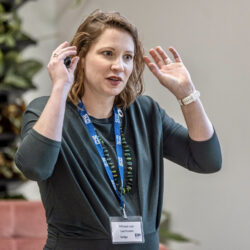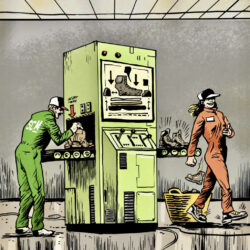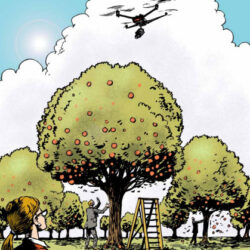Complexity is a barrier to supply chain sustainability
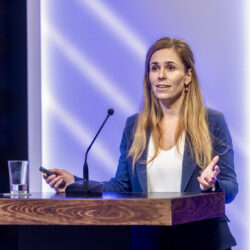
Anyone striving to make their supply chain more sustainable must keep their sustainability processes simple, above all else. This became evident during the third edition of the SCM Talkshow featuring Anne van de Poel (Bonduelle) and Roland van Bussel (Moonen Packaging), and hosted by Martijn Lofvers. Van de Poel: “If sustainability results in a complex and time-consuming operation, it won’t work. Complexity is a major barrier to further sustainability.”
By Marcel te Lindert
Very few people Anne van de Poel meets in her line of work as Supply Chain Director Northern Europe at Bonduelle are anti-sustainability. “Yet there is something that keeps many companies from making a start on it. That is often either money, priority or ambition, and sometimes it’s a lack of knowledge or data. That’s what we need to discuss with supply chain partners. We can only make headway with sustainability if we can succeed in removing barriers together. And that might mean we have to include other criteria in logistics tenders, besides just low price and high quality.”
Consolidating transport flows
Bonduelle’s sustainability ambitions stem from two beliefs: that there is a close link between the health of people and of the planet, and that a plant-based diet holds the key for both. With 30 factories and 2,000 ‘farming partners’, the family-owned company makes a major contribution to this. “We operate globally, but believe in a local approach. We believe that the product should be grown in the ground in the optimal location. And preferably that it should be processed and sold as close to that location as possible, not least to ensure minimum carbon emissions.”
The trend toward more local supply chains creates challenges, Van de Poel noted. “Especially in terms of scale because they are often a lot smaller, which leads to narrower transport flows. It takes an enterprising approach to find a solution for that. We have to analyse flows, collect data and brainstorm with our logistics service providers. And we sometimes have to reach out to competitors to consolidate flows, which is particularly difficult – because where should we start? With other clients of our logistics service providers? Or should we contact other large food producers directly? And sometimes we discover that it’s simply not practical to consolidate flows.”
Measuring and reporting on carbon emissions
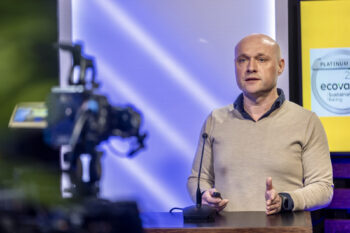 Packaging wholesaler Moonen Packaging is another company looking for ways to improve the sustainability of its transport. It has set itself the goal that the internal supply chain and the downstream supply chain to customers must be carbon-neutral by the end of 2026. Operational Director Roland van Bussel commented: “The internal supply chain is not the problem. We are in a sustainable building that is gas-free and has solar panels. But downstream, we still need to eliminate 250 tonnes of CO2 from the chain. We work with around five carriers, and we want to link them to the BigMile platform. That will enable us to measure and report shipment-level carbon emissions to our customers. We hope this will encourage them to make more sustainability-conscious purchasing decisions, leading to fewer shipments and fuller trucks.”
Packaging wholesaler Moonen Packaging is another company looking for ways to improve the sustainability of its transport. It has set itself the goal that the internal supply chain and the downstream supply chain to customers must be carbon-neutral by the end of 2026. Operational Director Roland van Bussel commented: “The internal supply chain is not the problem. We are in a sustainable building that is gas-free and has solar panels. But downstream, we still need to eliminate 250 tonnes of CO2 from the chain. We work with around five carriers, and we want to link them to the BigMile platform. That will enable us to measure and report shipment-level carbon emissions to our customers. We hope this will encourage them to make more sustainability-conscious purchasing decisions, leading to fewer shipments and fuller trucks.”
It’s a lot more difficult to make the other part of the supply chain more sustainable. “In that case, it’s about the packaging itself and how it is produced. The packaging industry is quite traditional and difficult to persuade to use sustainable transport, for example, but we are going to try. As a wholesaler we are relatively small, but we can exert slightly more influence because we’re part of the OptiGroup. Plus as a wholesaler, we have the advantage of being able to choose suppliers. We are now investigating whether we can allocate more volume to suppliers with sustainable operations.”
Circular supply chain
A sustainable supply chain ultimately also means a circular supply chain. During the SCM Talkshow, it became clear that Bonduelle is striving for recyclable – and preferably reusable – packaging, and intends to completely eliminate all plastic packaging based on fossil raw materials by 2030 at the latest. ‘‘We, too, are thinking about reusable packaging,” said Van Bussel. “That’s where we are headed, even when it comes to e-commerce packaging. That means we will have to deal with return flows, which requires reusable packaging to be tagged so we know where it is.”
In its circular service named ‘Happy Plastic’, Moonen has already started recovering packaging film, which is processed into raw material for new packaging film. Meanwhile, Bonduelle is exploring the possibilities of joining Too Good To Go, an initiative to combat food waste. “They work with food producers to create parcels of items that are past retailers’ best-before dates but are still safe to eat. If it’s easy for us to provide those items, I don’t see any reason why Bonduelle can’t participate,” said Van de Poel.
Keep it simple
That brought the discussion back round to where it started: how can the barriers to sustainability be removed? “The idea of Happy Plastic originated from one employee’s enthusiasm. We have launched it with a number of customers, but it is still in its infancy. Sometimes, rather than waiting until you’ve got all the data you need, you should just make a start. Then you automatically come up against all the barriers that need to be removed,” Van Bussel stated. Van de Poel added: “The most important thing about this kind of initiative is to keep the process as simple as possible. If it’s a complex process that takes up a lot of people’s time, it won’t work. Complexity is a major barrier to supply chain sustainability.”



